Integrating a Spatially Explicit Tradeoff Analysis for Sustainable Land Use Optimal Allocation
Abstract
:1. Introduction
2. Materials and Methods
2.1. Study Area
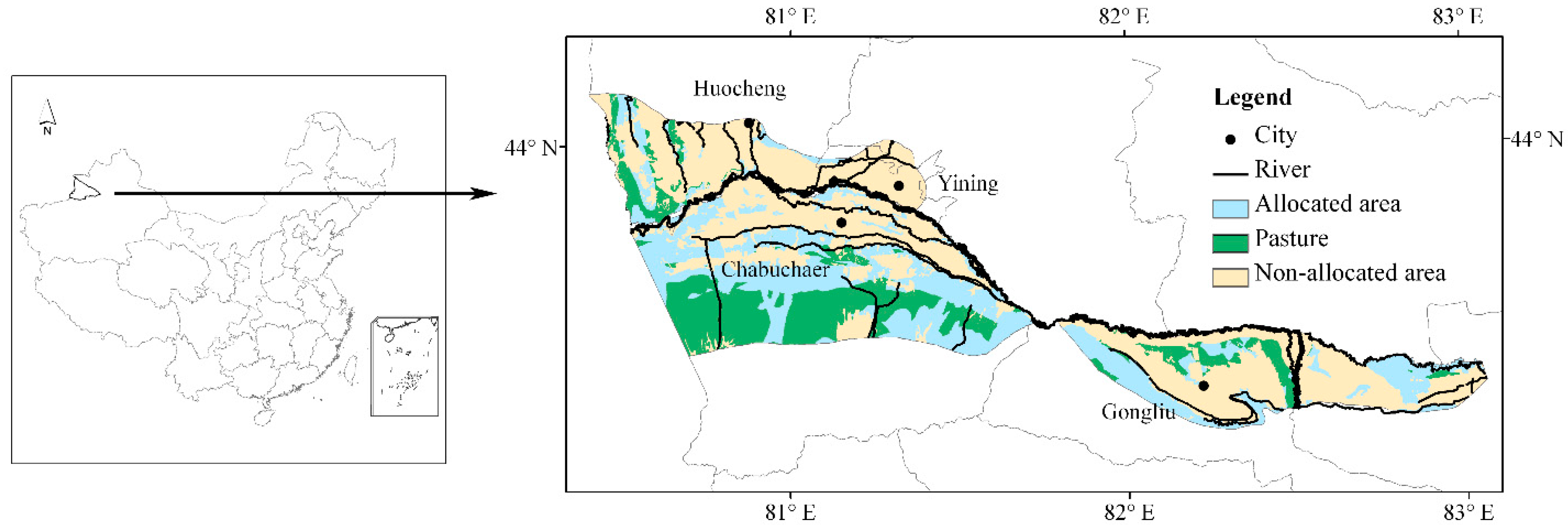
2.2. Methods and Data Description

2.2.1. Land Use Spatial Allocation
| Criterion | Input dataset | Data source | Format | Processing |
|---|---|---|---|---|
| Soil texture | 1:100,000 Soil type maps of Yili region | Institute of Geographical Sciences and Natural Resources Research | polygon | Format transformation |
| Soil depth | Soil sampling points | Fieldwork by the research team | point | Kriging interpolation |
| Soil organic matter | Soil sampling points | Fieldwork by the research team | point | Kriging interpolation |
| Sand dune waviness | 1:50,000 Topographic maps; Land use map 2008 | Institute of Geographical Sciences and Natural Resources Research;
Data Center for Resources and Environmental Sciences, Chinese Academy of Sciences | raster | Selecting the sand distribution from the land use map and calculating the relative height from the DEM digitized from the topographic maps |
| Soil erosion | 1:50,000 Topographic maps | Institute of Geographical Sciences and Natural Resources Research | raster | Calculating the gully density from the above DEM |
| Water supply and drainage | 1:100,000 Land resource map of China | Institute of Geographical Sciences and Natural Resources Research | raster | Resampling |
| Salinity | 1:100000 Soil type maps of Yili region; 1:1000000 Land resource map | Institute of Geographical Sciences and Natural Resources Research | raster | Format transformation |
| > 10 °C accumulated temperature | 1:1000000 Accumulated temperature map of Yili region | Institute of Geographical Sciences and Natural Resources Research | raster | Format transformation |
| Nearest distance to towns | 1:100000 Spatial map of towns in Yili region | Data Center for Resources and Environmental Sciences, Chinese Academy of Sciences | raster | Distance calculation |
| Nearest distance to roads | 1:100000 Spatial map of roads in Yili region | Data Center for Resources and Environmental Sciences, Chinese Academy of Sciences | raster | Distance calculation |
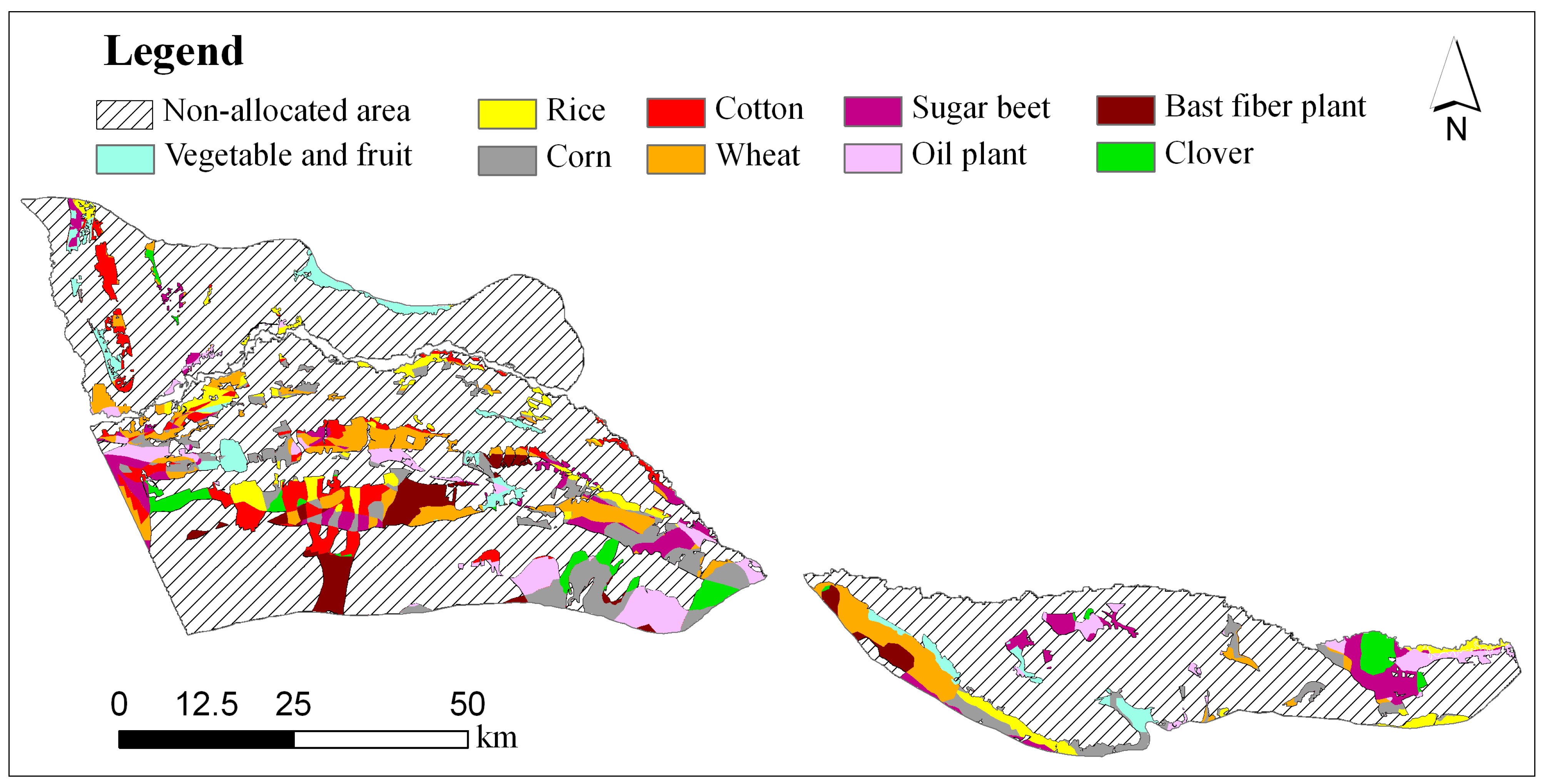
2.2.2. Conceptual Framework of Tradeoff Analysis
2.2.3. Crop Yield Simulation
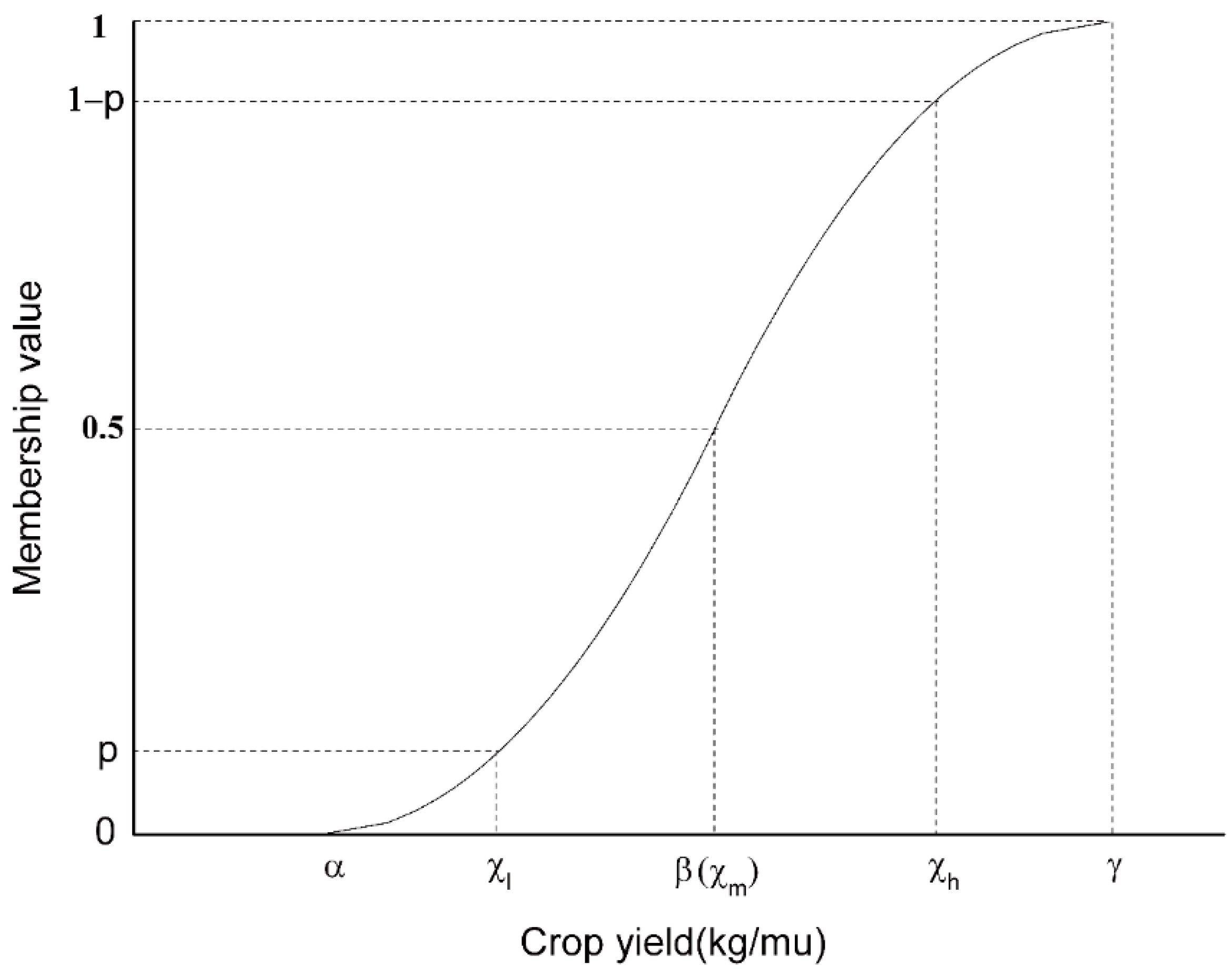
2.2.4. Ecosystem Service Value Estimation
2.2.5. Procedure of Spatial Tradeoff Analysis
| Crop price (yuan/kg) | Crop cost (yuan/ha) | Mean crop yield (kg/ha) | High crop yield (kg/ha) | Low crop yield (kg/ha) | |
|---|---|---|---|---|---|
| Wheat | 1.80 | 5209.8 | 5250 | 7500 | 3000 |
| Corn | 1.30 | 5621.55 | 10,500 | 15,000 | 6000 |
| Rice | 1.85 | 5545.35 | 8250 | 11,250 | 5250 |
| Cotton | 12.00 | 6151.05 | 1500 | 2025 | 975 |
| Sugar beet | 0.28 | 9925.05 | 54,000 | 75,000 | 33,000 |
| Oil plant | 4.80 | 4640.55 | 2250 | 3000 | 1500 |
| Bast fiber plant | 2.20 | 6083.1 | 4875 | 6750 | 3000 |
| Vegetables and fruit | 0.77 | 25,041 | 67,500 | 75,000 | 60,000 |
| Clover | 1.00 | 4500 | 7500 | 10,500 | 4500 |
3. Results and Discussion
3.1. Tradeoff Analysis for Land Use Optimal Allocation by the Payment Policy
3.1.1. Key Parameters for Tradeoff Analysis

3.1.2. Tradeoff Analysis for Farmers’ Adoption by Payments

3.1.3. Land Use Reallocation with the Tradeoff Analysis
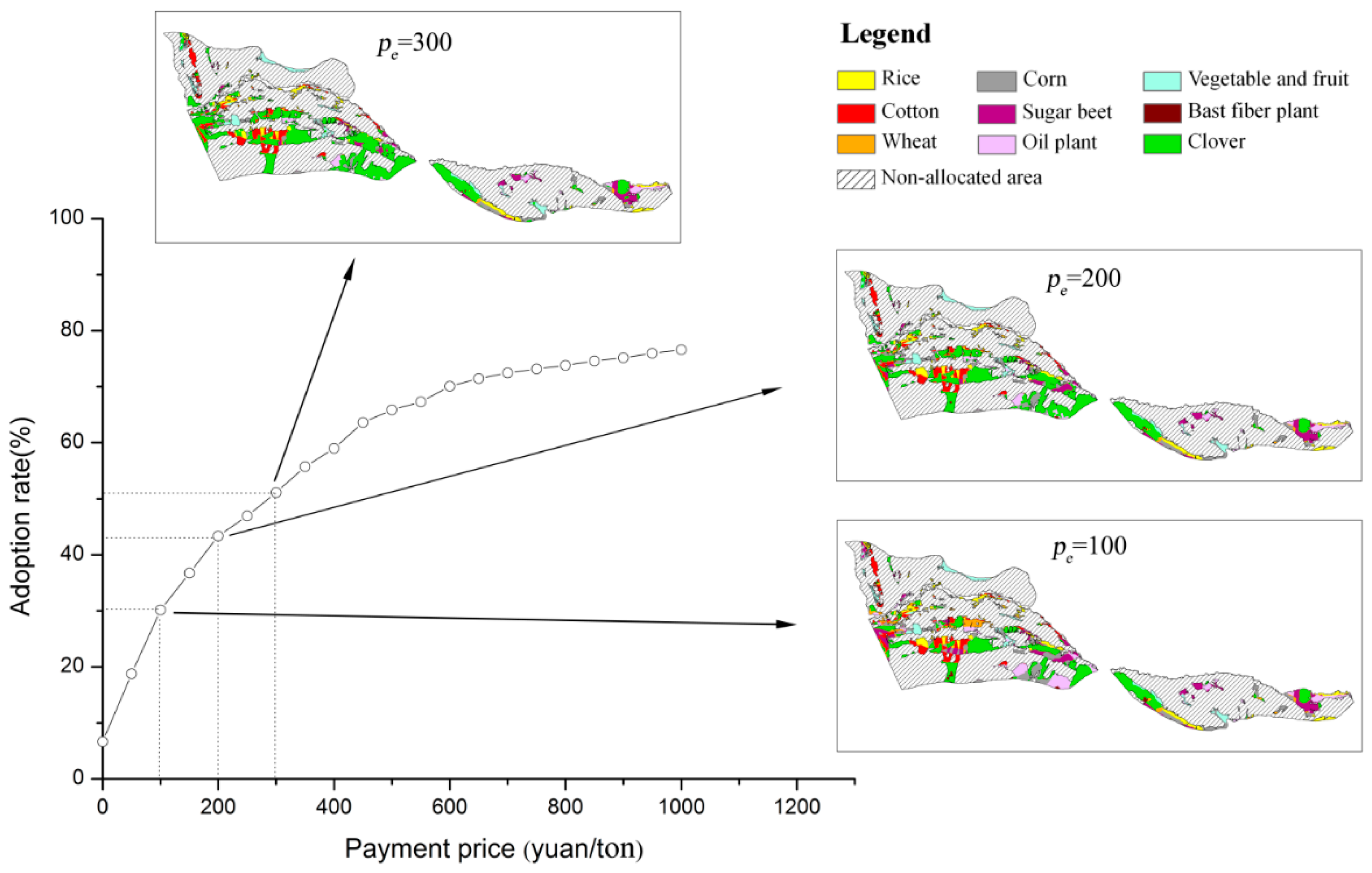
| Payment price (yuan/ton) | Reference scenario | pe = 50 | pe = 100 | pe = 150 | pe = 200 | pe = 250 | pe = 300 | pe = 350 | pe = 400 | pe = 450 | pe = 500 |
|---|---|---|---|---|---|---|---|---|---|---|---|
| Wheat | 3.08 | 2.01 | 1.16 | 0.78 | 0.47 | 0.38 | 0.31 | 0.20 | 0.13 | 0.11 | 0.10 |
| Corn | 2.41 | 2.36 | 2.02 | 1.84 | 1.61 | 1.51 | 1.25 | 1.11 | 1.05 | 0.93 | 0.87 |
| Rice | 1.23 | 1.16 | 1.16 | 1.16 | 1.16 | 1.12 | 1.05 | 0.91 | 0.84 | 0.83 | 0.80 |
| Cotton | 1.48 | 1.36 | 1.36 | 1.36 | 1.36 | 1.36 | 1.36 | 1.36 | 1.27 | 0.86 | 0.73 |
| Sugar beet | 1.68 | 1.52 | 1.52 | 1.40 | 1.21 | 1.05 | 0.96 | 0.86 | 0.76 | 0.73 | 0.68 |
| Oil plant | 0.81 | 0.75 | 0.73 | 0.58 | 0.45 | 0.40 | 0.35 | 0.25 | 0.21 | 0.20 | 0.19 |
| Bast fiber plant | 0.62 | 0.35 | 0.08 | 0.05 | 0.04 | 0.02 | 0.01 | 0.00 | 0.00 | 0.00 | 0.00 |
| Vegetables and fruit | 1.09 | 1.09 | 1.09 | 1.09 | 1.09 | 1.09 | 1.09 | 1.09 | 1.09 | 1.09 | 1.09 |
| Clover | 0.65 | 2.45 | 3.93 | 4.79 | 5.66 | 6.12 | 6.67 | 7.27 | 7.70 | 8.30 | 8.59 |
3.2. Sensitivity Analysis for the Tradeoff Analysis
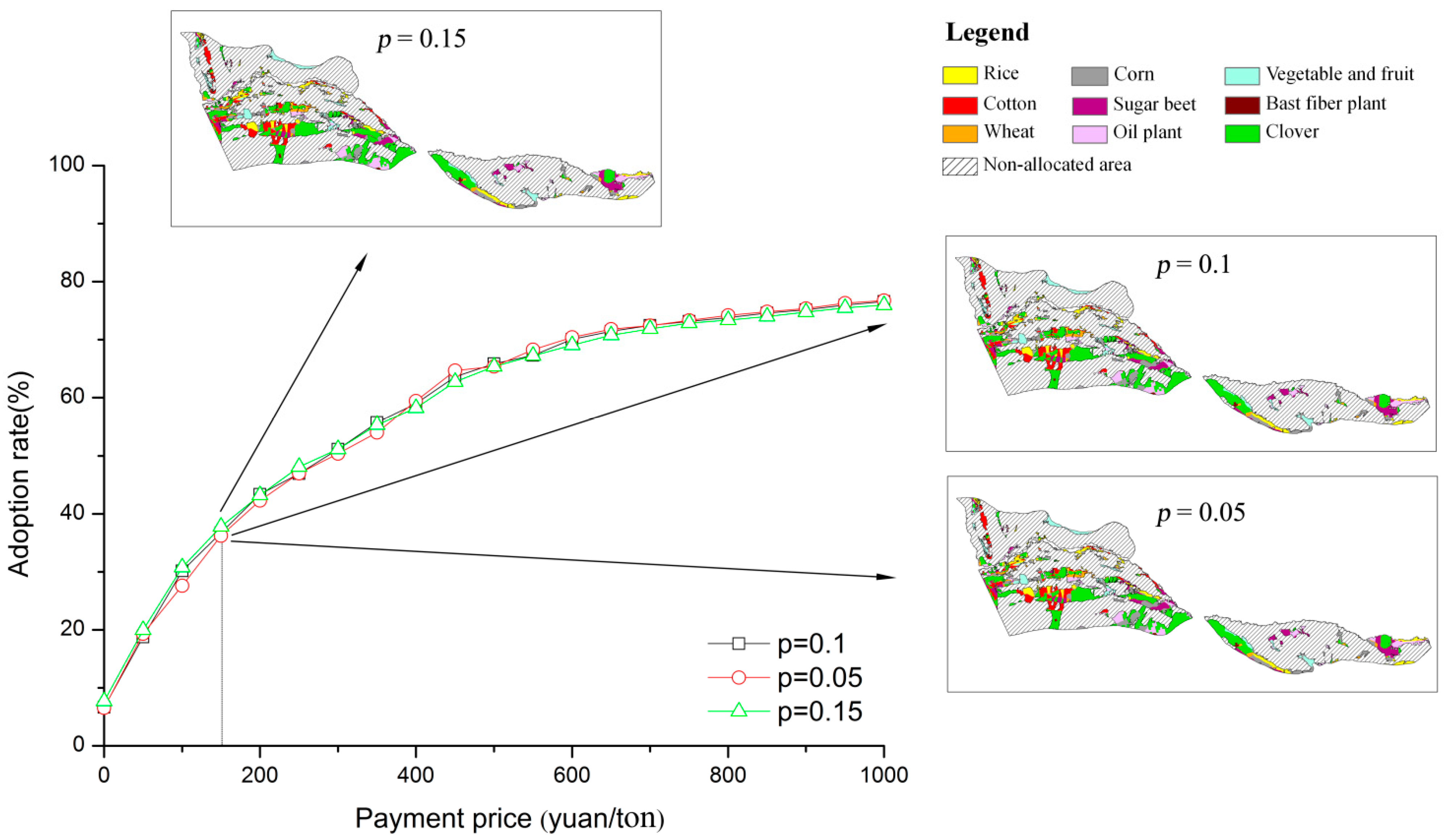

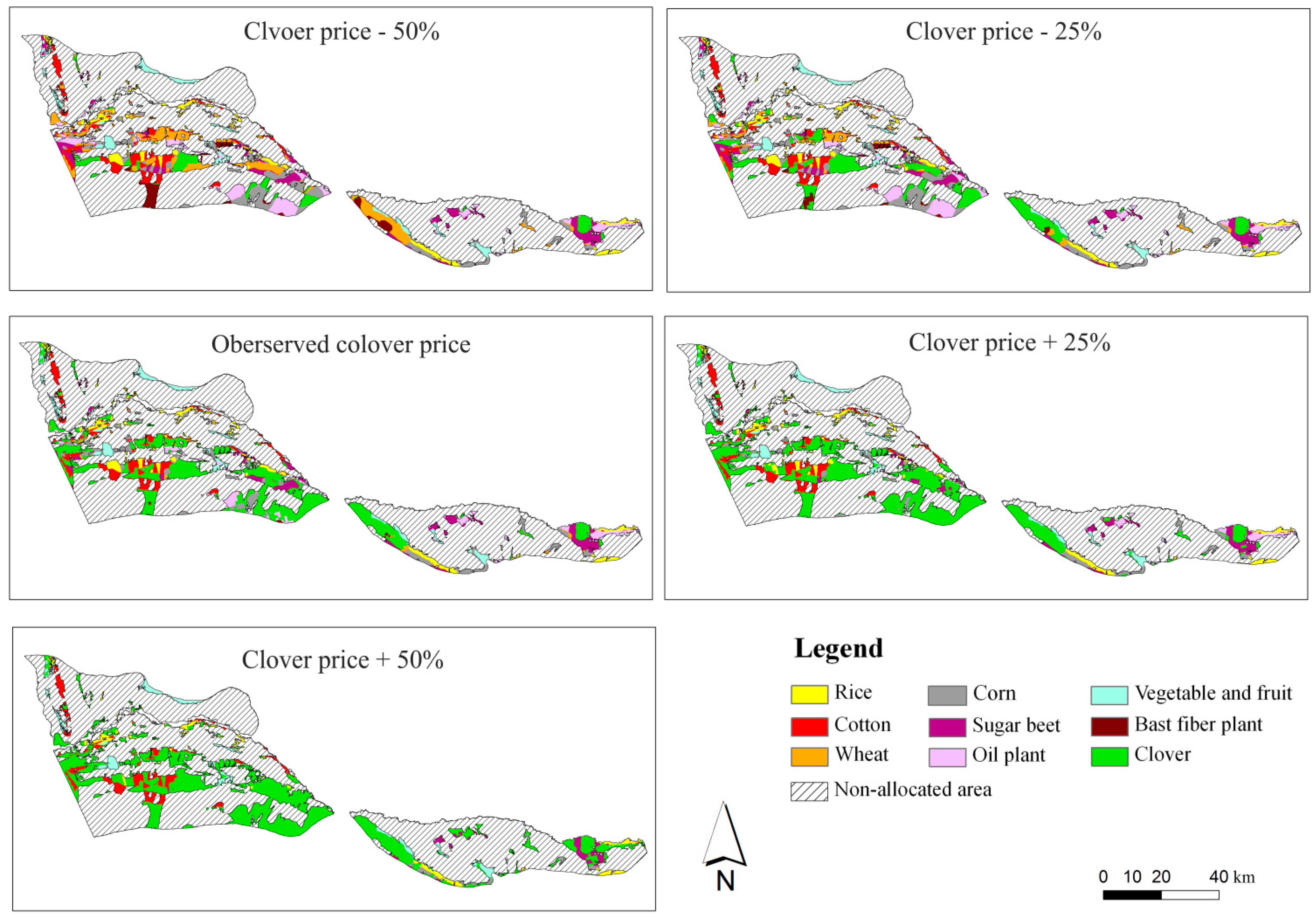
4. Discussion
4.1. Advantage of Spatially Explicit Tradeoff Analysis on Sustainable Land Use Planning
4.2. Uncertainties of Tradeoff Analysis
5. Conclusions
Acknowledgments
Author Contributions
Conflicts of Interest
References
- Tilman, D.; Cassman, K.G.; Matson, P.A.; Naylor, R.; Polasky, S. Agricultural sustainability and intensive production practices. Nature 2002, 418, 671–677. [Google Scholar] [CrossRef] [PubMed]
- Godfray, H.C.J.; Beddington, J.R.; Crute, I.R.; Haddad, L.; Lawrence, D.; Muir, J.F.; Pretty, J.; Robinson, S.; Thomas, S.M.; Toulmin, C. Food security: The challenge of feeding 9 billion people. Science 2010, 327, 812–818. [Google Scholar] [CrossRef] [PubMed]
- Robertson, G.P.; Swinton, S.M. Reconciling agricultural productivity and environmental integrity: A grand challenge for agriculture. Front. Ecol. Environ. 2005, 3, 38–46. [Google Scholar] [CrossRef]
- Pretty, J. Agricultural sustainability: Concepts, principles and evidence. Philos. Trans. R. Soc. B Biol. Sci. 2008, 363, 447–465. [Google Scholar] [CrossRef]
- Liu, Y.; Wang, H.; Ji, Y.; Liu, Z.; Zhao, X. Land use zoning at the county level based on a multi-objective particle swarm optimization algorithm: A case study from Yicheng, China. Int. J. Environ. Res. Public Health 2012, 9, 2801–2826. [Google Scholar] [CrossRef] [PubMed]
- Santé-Riveira, I.; Boullón-Magán, M.; Crecente-Maseda, R.; Miranda-Barrós, D. Algorithm based on simulated annealing for land-use allocation. Comp. Geosci. 2008, 34, 259–268. [Google Scholar] [CrossRef]
- Cao, K.; Huang, B.; Wang, S.; Lin, H. Sustainable land use optimization using Boundary-Based Fast Genetic Algorithm. Comp. Environ. Urban Syst. 2012, 36, 257–269. [Google Scholar] [CrossRef]
- Gong, J.; Liu, Y.; Chen, W. Optimal land use allocation of urban fringe in Guangzhou. J. Geogr. Sci. 2012, 22, 179–191. [Google Scholar] [CrossRef]
- Wang, S.-H.; Huang, S.-L.; Budd, W.W. Integrated ecosystem model for simulating land use allocation. Ecol. Model. 2012, 227, 46–55. [Google Scholar] [CrossRef]
- Crissman, C.C.; Antle, J.M.; Capalbo, S.M. Economic, Environmental, and Health Tradeoffs in Agriculture: Pesticides and the Sustainability of Andean Potato Production; International Potato Center: Dordrecht, The Netherlands, 1998. [Google Scholar]
- Antle, J.M.; Stoorvogel, J.J.; Crissman, C.C.; Bowen, W. Tradeoff Assessment as a Quantitative Approach to Agricultural/Environmental Policy Analysis. In Proceedings of the SAAD III Third International Symposium on Systems Approaches for Agricultural Development, Lima, Peru, 8–10 November 1999.
- Stoorvogel, J.; Antle, J.M.; Crissman, C.; Bowen, W. The tradeoff analysis model: Integrated bio-physical and economic modeling of agricultural production systems. Agric. Syst. 2004, 80, 43–66. [Google Scholar] [CrossRef]
- Antle, J.; Stoorvogel, J.; Bowen, W.; Crissman, C.; Yanggen, D. The tradeoff analysis approach: Lessons from Ecuador and Peru. Q. J. Int. Agric. 2003, 42, 189–206. [Google Scholar]
- Immerzeel, W.; Stoorvogel, J.; Antle, J. Can payments for ecosystem services secure the water tower of Tibet? Agric. Syst. 2008, 96, 52–63. [Google Scholar] [CrossRef]
- Claessens, L.; Antle, J.; Stoorvogel, J.; Valdivia, R.; Thornton, P.; Herrero, M. A method for evaluating climate change adaptation strategies for small-scale farmers using survey, experimental and modeled data. Agric. Syst. 2012, 111, 85–95. [Google Scholar] [CrossRef] [Green Version]
- Jack, B.K.; Leimona, B.; Ferraro, P.J. A revealed preference approach to estimating supply curves for ecosystem services: Use of auctions to set payments for soil erosion control in Indonesia. Conserv. Biol. 2009, 23, 359–367. [Google Scholar] [CrossRef] [PubMed]
- Antle, J.M.; Diagana, B.; Stoorvogel, J.J.; Valdivia, R.O. Minimum-data analysis of ecosystem service supply in semi-subsistence agricultural systems. Aust. J. Agric. Resour. Econ. 2010, 54, 601–617. [Google Scholar] [CrossRef]
- Antle, J.M.; Valdivia, R.O. Modelling the supply of ecosystem services from agriculture: A minimum-data approach. Aust. J. Agric. Resour. Econ. 2006, 50, 1–15. [Google Scholar] [CrossRef]
- Kang, L.; Zhang, H. Assessment of the Land Desertification Sensitivity of Newly Reclaimed Area in Yili, Xinjiang. Resour. Sci. 2012, 34, 896–902. (In Chinese) [Google Scholar]
- Zhang, Y.; Zhang, H.; Ni, D.; Song, W. Agricultural land use optimal allocation system in developing area: Application to Yili watershed, Xinjiang Region. Chin. Geogr. Sci. 2012, 22, 232–244. [Google Scholar] [CrossRef]
- Shi, Y. Opinions on the land development in Yili region. Xinjiang Agric. Sci. 2008, 45, 1–3. [Google Scholar]
- Food and Agriculture Organisation (FAO). A Framework for Land Evaluation (Soils Bulletin No. 32); Food and Agriculture Organisation of the United Nations: Rome, Italy, 1976. [Google Scholar]
- Rossiter, D.G. A theoretical framework for land evaluation. Geoderma 1996, 72, 165–190. [Google Scholar] [CrossRef]
- Nisar Ahamed, T.; Gopal Rao, K.; Murthy, J. GIS-based fuzzy membership model for crop-land suitability analysis. Agric. Syst. 2000, 63, 75–95. [Google Scholar]
- Kalogirou, S. Expert systems and GIS: An application of land suitability evaluation. Comp. Environ. Urban Syst. 2002, 26, 89–112. [Google Scholar] [CrossRef]
- Verheye, W. Land evaluation. In Land Use, Land Cover and Soil Sciences; UNESCO-EOLSS Publishers: Oxford, UK, 2008. [Google Scholar]
- Dumanski, J.; Onofrei, C. Techniques of crop yield assessment for agricultural land evaluation. Soil Use Manag. 1989, 5, 9–15. [Google Scholar] [CrossRef]
- Tang, H.; Debaveye, J.; Ruan, D.; van Ranst, E. Land suitability classification based on fuzzy set theory. Pedologie 1991, 41, 277–290. [Google Scholar]
- Keshavarzi, A.; Sarmadian, F.; Ahmadi, A. Spatially-based model of land suitability analysis using Block Kriging. Aust. J. Crop Sci. 2011, 5, 1533–1541. [Google Scholar]
- Samranpong, C.; Ekasingh, B.; Ekasingh, M. Economic land evaluation for agricultural resource management in Northern Thailand. Environ. Model. Softw. 2009, 24, 1381–1390. [Google Scholar] [CrossRef]
- Van Ranst, E.; Tang, H.; Groenemam, R.; Sinthurahat, S. Application of fuzzy logic to land suitability for rubber production in peninsular Thailand. Geoderma 1996, 70, 1–19. [Google Scholar]
- Costanza, R.; d’Arge, R.; de Groot, R.; Farber, S.; Grasso, M.; Hannon, B.; Limburg, K.; Naeem, S.; O’Neill, R.V.; Paruelo, J.; et al. The value of the world’s ecosystem services and natural capital. Nature 1997, 387, 253–260. [Google Scholar] [CrossRef]
- Kinnell, P. Event soil loss, runoff and the Universal Soil Loss Equation family of models: A review. J. Hydrol. 2010, 385, 384–397. [Google Scholar] [CrossRef]
- Cai, C.; Ding, S.; Shi, Z.; Huang, L.; Zhang, G. Study of Applying USLE and Geographical Information System IDRISI to Predict Soil Erosion in Small Watershed. J. Soil. Water Conserv. 2000, 14, 19–24. (In Chinese) [Google Scholar]
- Geospatial Data Cloud. http://www.gscloud.cn/ (accessed on 25 November 2014).
- Data Sharing Infrastructure of Earth System Science. http://www2.geodata.cn/data/dataresource.html (accessed on 25 November 2014).
- Yili Municipal Bureau of Statistics. Yili Kazakh Autonomous Prefecture Statistical Yearbook; Yili Municipal Bureau of Statistics: Xinjiang, China, 2007. [Google Scholar]
- Claessens, L.; Stoorvogel, J.; Antle, J.M. Ex ante assessment of dual-purpose sweet potato in the crop-livestock system of western Kenya: A minimum-data approach. Agric. Syst. 2008, 99, 13–22. [Google Scholar] [CrossRef]
- Williams, J.R.; Singh, V. The EPIC Model. In Computer Models of Watershed Hydrology; Water Resources Publisher: Colorado, CO, USA, 1995; pp. 909–1000. [Google Scholar]
- Keating, B.A.; Carberry, P.; Hammer, G.; Probert, M.E.; Robertson, M.; Holzworth, D.; Huth, N.; Hargreaves, J.; Meinke, H.; Hochman, Z. An overview of APSIM, a model designed for farming systems simulation. Eur. J. Agron. 2003, 18, 267–288. [Google Scholar] [CrossRef]
- Jones, J.W.; Hoogenboom, G.; Porter, C.; Boote, K.; Batchelor, W.; Hunt, L.; Wilkens, P.; Singh, U.; Gijsman, A.; Ritchie, J. The DSSAT cropping system model. Eur. J. Agron. 2003, 18, 235–265. [Google Scholar] [CrossRef]
© 2014 by the authors; licensee MDPI, Basel, Switzerland. This article is an open access article distributed under the terms and conditions of the Creative Commons Attribution license (http://creativecommons.org/licenses/by/4.0/).
Share and Cite
Xu, E.; Zhang, H.; Yang, Y.; Zhang, Y. Integrating a Spatially Explicit Tradeoff Analysis for Sustainable Land Use Optimal Allocation. Sustainability 2014, 6, 8909-8930. https://doi.org/10.3390/su6128909
Xu E, Zhang H, Yang Y, Zhang Y. Integrating a Spatially Explicit Tradeoff Analysis for Sustainable Land Use Optimal Allocation. Sustainability. 2014; 6(12):8909-8930. https://doi.org/10.3390/su6128909
Chicago/Turabian StyleXu, Erqi, Hongqi Zhang, Yang Yang, and Ying Zhang. 2014. "Integrating a Spatially Explicit Tradeoff Analysis for Sustainable Land Use Optimal Allocation" Sustainability 6, no. 12: 8909-8930. https://doi.org/10.3390/su6128909




